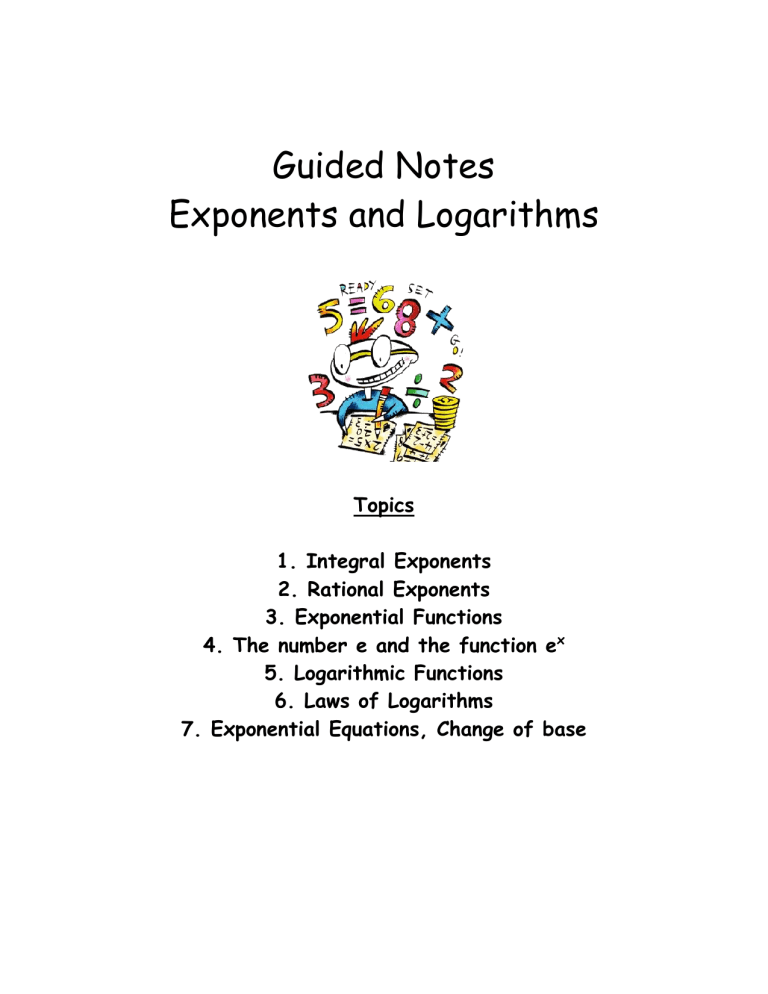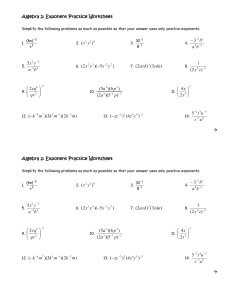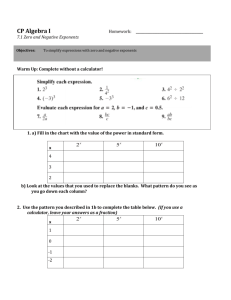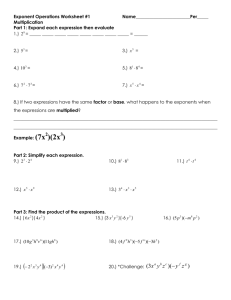DO NOW

Guided Notes
Exponents and Logarithms
Topics
1. Integral Exponents
2. Rational Exponents
3. Exponential Functions
4. The number e and the function e x
5. Logarithmic Functions
6. Laws of Logarithms
7. Exponential Equations, Change of base
Section 1: Integral Exponents
Students will be able to simplify expressions using properties of integral exponents
DO NOW
Write each number as a square of a number.
1.
25 2. 0.09
Write each expression as a square of an expression.
3. x 10 4. 169x 6 y 12
Review
Properties of Exponents
Assume that no denominator is equal to zero and m and n are integers
Examples
1.
Simplify and rewrite each expression using only positive integers. a.
( )
2x 3
0 b.
( )
4
( )
5
𝑐.
6𝑎
3 𝑏
−2 𝑐
5 𝑎𝑏 −3 𝑐 2 d.
(
3x 3 y 4
) 2 e. æ
æ
2x
æ
3 y 2
3
æ
æ
3 g.
(𝑎 −2 + 𝑏 −2 ) −1 i.
𝑥 5 𝑥
∙𝑥
−3
−2 f.
æ
æ
3r
æ
2 s
3rs
3 t h. 𝑥
5
+𝑥
−2 𝑥 −3
0 æ
æ
3
2.
Suppose the cost of a hamburger has been increasing at the rate 9% per year. Then, each year the cost is 1.09 times the cost in the previous year. Suppose that the cost now is $4. Use this information to fill in the projected future costs in the table below.
Time(years from now)
0 1 2 3
Cost(dollars) 4 t
Can we write a cost function for C(t) to describe this situation?
Use the cost function that you wrote to find the cost of a hamburger a) 5 years from now and b) 5 years ago.
This is an example of exponential GROWTH.
How would the equation change if it was exponential decay?
Growth and Decay can be modeled by the equation:
A(t) = A
0
(1+r) t
A
0= t= r =
3.
Suppose that a radioactive isotope decays so that the radioactivity present decreases by 15% per day. If 40 kg are present now, find the amount present a)6 days from now and b) 6 days ago.
Worksheet p. 173 #14-32 even p. 174 #41
Section 2 Part 1: Rational Exponents
Students will be able to define and apply rational exponents.
DO NOW
Simplify.
1.
2 –4 2. (3x) –2
3.
(5x 2 y) –3 4. (2a –2 b 3 ) 4
Key Concepts
Rational Exponent
If the nth root of a is a real number, m is an integer and m/n is in lowest terms, then
a
1 n = n a and a m n = n a m
Examples
1. Convert to radical form. a. 𝑥
3
7 a.
a
5
2. Convert to exponential form. b. b.
y
3.5
3
3. Simplify. a.
64
1
3 b.
7
1
2
∙ 7
1
2 c.
5
1
4
∙ 125
1
4
Key Concepts
All the properties of integer exponents also apply to rational exponents.
Examples
1) 4 1/2 2) 4 -1/2 3) 4 3/2 4) 4 -3/2
5) -9 1/2 6) -9 -1/2 7) (3 1/2 ∙ 5 1/2 ) 2 8) (3 1/2 + 5 1/2 ) 2
9) (
49
)
25
−
1
2
10) (
4
9
)
3
2
11) (8 -1/6 ) -2 12) 8 3/2 ∙ 2 3/2
13) (2x -1/3 )3 14)
(
125 𝑥 6
)
1
3 𝑥
1
3
15)
2𝑥
−
2
3
16) 2x 3/2 ∙ 4x -1/2
Worksheet p. 178 #2-12 even
Section 2 Part 2: Rational Exponents
Students will be able to solve equations containing exponents.
DO NOW
Solve the following for x.
1.) 2 –4 = 2 x 2.) 2 x+1 = 2 3
EQUATION TYPE #1: X is the exponent.
Express both sides of the equation as powers of the same base. Then use the idea that if b x = b y , then x=y.
Examples
1. 2 x = 8 2. 2 x =
1
8
3. 9 x+1 = √27 4. 3 2x = 3 12
5. 9 x = 3 5
EQUATION TYPE #2: x is the base.
Raise both sides of the equation to the same power to eliminate the exponent.
EXAMPLES
1. x 1/4 = 2 2. X 2/3 = 9
3. 4x 3/2 = 32
5. (x-1) -1/4 – 2 = 0
4. X -1/2 = 4
6. A house bought 5 years ago for $100,000 was just sold for $135,000.
To the nearest tenth of a percent, what was the annual growth rate?
HW: worksheet p. 178 # 18—36 even





